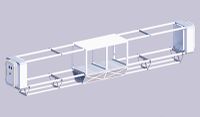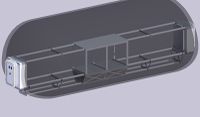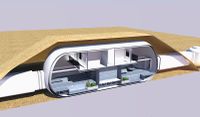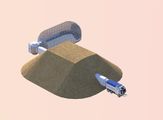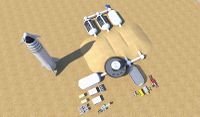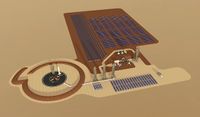Inflatable habitat
Surface habitats used to create a settlement could be inflatable like NASA's transhab project. The modules would be unfolded, inflated, connected together and covered with regolith. The insides of the habitats would then be outfitted.
Benefits
Inflatable habitats offer the most benefit to initial settlements and outposts which require buildings shipped from Earth. They offer greater space than rigid habitats of the same initial volume.
An Earth atmosphere pressurized inflatable habitat has an internal pressure of 5 to 10 tonnes per m2 (50 to 100 kPa). Density of regolith is about 1500 kg/m3, this corresponds to 525 kg of soil pressure per m2 at Mars gravity. So the habitat can support up to 19m of regolith. Studies have shown than a single meter of regolith may be sufficient for radiation protection for both solar storms and GCRs.[1]. So an inflatable habitat may well be buried for radiation protection.
Disadvantages
- An inflatable may be more prone to catastrophic collapse in case of structural failure, or leaks.
- An inflatable might be more easily damaged by fire, and materials might be more inherently flammable.
- Although an inflatable has packing volume advantages, this may not be significant for habitats built on Mars from In-situ resources.
- Fabrics may be susceptible to fatigue.
- If the radiation protection is in the form of sandbags, an inflatable habitat is more likely to collapse.
Example
A simple inflatable habitat for a Martian settlement, 8m x 20m. The structure is extended then the volume is inflated. Once the module is stable, it can be buried under regolith for radiation protection. There are two floors for a total volume of about 1000m3 and a typical floor space of 240 m2. This design could house eight occupants.
| Concepts: | Greenhouse · Settlements · Locations · General |
| Hazards: | Space Weather · Climate · General |
| Technology: | Hi-Tech · Lo-Tech · Energy · Spaceflight science · Communication · General |
| Human Considerations: | Economics · Health · Governance · Trade · Law · Social |
References
- ↑ Regolth radiation protection- https://eps.utk.edu/faculty/taylor/Miller-radiation%20measurement.pdf


